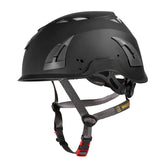We all know working at height presents very real risks.
And unfortunately, some level of risk will always exist. The challenge we face going forward is ensuring that risk is always front-of-mind, so we can put proactive and reactive measures in place to keep our tradespersons safe at height.
That said, it’s not all doom and gloom. Huge strides have been made in this arena in recent decades and health and safety on site has improved drastically. But this is a journey, and there’s more to be done. This was highlighted by recent figures from the Health and Safety Executive (HSE), which revealed an increase in deaths within the construction industry. 39 workers sadly lost their lives due to injuries sustained while at work, a rise in the annual average of 36 between 2016/17 and 2020/21. The most common cause of fatal injuries was workers falling from height[1].
At Leach’s, our aim is to support your efforts to reduce that risk.
Together, we can create a safer working environment for all. We believe that with sound preparation and the right height safety equipment, we can significantly reduce the frequency of accidents and injuries. The highest of standards must be upheld across sectors such as scaffolding and construction, with safety plans and equipment constantly reviewed and inspected to ensure the most appropriate working at height safety measures are always deployed.
In this guide, we’ll outline what working at height is, re-affirm some of the key regulations that apply, and discuss what employers and employees need to know to keep everyone on the team safe.
What is working at height?
According to the Work at Height Regulations 2005[2], working at height refers to:
“Work in any place, including a place at or below ground level, or obtaining access to or egress from such a place, while at work, except by a staircase, where, if suitable measures were not taken, a person could fall a distance likely to cause personal injury.”
Simply put, any work conducted whereby a fall from distance could cause personal injury is classed as working at height. Typical examples of work at height include:
- Working on a ladder
- Working on a flat roof
- Working on fragile surfaces
- Working near a hole in the ground or an opening in the floor.
What height safety regulations apply?
Whether you’re a business owner or an employee, it’s critical you and your team are acutely aware of all the relevant legislation and regulations that apply within your sector to mitigate against any risk.
Most importantly, if you or your employees are working at height, you will need to comply with the Work at Height Regulations 2005. These regulations apply to an employer or if you control the work at height. Any such work must be properly planned, supervised, and carried out by competent people with measures in place to protect everyone at risk. Non-compliance with the relevant legislations could result in:
- You and your team being at risk of injury due to poor safety practices
- Potential fines and site closures
But that’s not the only regulation you should be looking out for.
Certain height safety equipment and PPE will have their own specific regulations that indicate their levels of safety.
For example, if you use a height safety helmets on-site, you should be looking out for the BS EN 397 safety helmet standard, which outlines the physical and performance requirements for industrial safety helmets to ensure height safety helmets are specifically designed to protect the wearer from falling objects.
Furthermore, if you wear a safety harness on site, take note on if your harness adheres to the EN361:2002 full body harness regulations. These regulations put a harness through a rigorous performance test to ensure it can effectively hold the wearer in place and spread the weight load in case of a fall. You’ll need a safety harness you can count on.
How can I ensure compliance with the Work at Height Regulations 2005?
Most accidents at height occur on the roofs of factories, warehouses or farm buildings. From roof lights and liner panels to rotted chipboard, slates and tiles, it’s always possible an accident will happen if the correct safety measures are not implemented and adhered to.
To alleviate these risks and ensure compliance with the Work at Height Regulations, those managing work at height must:
- Do as much work as possible from the ground
- Ensure workers can get safely to and from where they work at height
- Ensure equipment is suitable, stable and strong enough for the job
- Maintain and inspect equipment regularly
- Make sure you don’t overload or overreach when working at height
- Take precautions when working on or near fragile surfaces
- Provide protection from falling objects
- Consider your emergency evacuation and rescue procedures
As an employer, what should I do to ensure my team are safe at height?
The most important action to take to ensure your team can work safely at height is deploying and following a strict assessment and planning process, such as Leach’s STRICTPLAAN Safety Model.
The STRICTPLAAN model is designed to cover the critical safety considerations when working at height, and entails:
S – Scenario – Evaluate the scenario
TR – Threats and risks – Understand the threats and risks
I – Instigate – Instigate proper planning
C – Competencies – Evaluate worker competencies
T – Training – Ensure thorough training
P – PPE – Choose quality PPE & height safety tools
L – Look – Look at your equipment before each use
A – Actionable – Create an actionable emergency evacuation plan
A – Assure – Assure regulatory compliance
N – Never – Never get complacent
Download the STRICTPLAAN Work at Height Safety Guide
As an employee, what should I do to ensure I work safely at height?
While it is the employers obligation to create an actionable safety plan, as an employee you must ensure you understand this plan and your responsibilities within it.
For example, one such responsibility is to conduct visual inspections of your safety equipment before each use. That helmet you’ve been wearing for years may’ve been the best available at the time, but is it in good shape now? Best to check before you put it on again.
Further to that, the BS EN 365: 2004 Personal protective equipment against falls from height standard instructs users of fall arrest equipment to re-certify equipment on a 12-monthly inspection schedule. Some textile webbing products such as fall arrest lanyards may need to be tested every 6-months at least, or every 3-months if being used in arduous conditions.
This re-certification process must be undertaken by a qualified and competent professional and should include:
- A description of the product
- The frequency and type of inspection required
- Who is authorised to conduct the inspection
- The actions that should be taken if the test fails
- The means of recording inspections
- The training of users
- The means of monitoring to verify inspections
Of course, you also need to ensure you behave appropriately while working at height. This means:
- Wearing the correct PPE
- Utilising the right height safety equipment and tools
- Understanding how to use the height safety equipment supplied and if not, requesting thorough training on its use
- Reporting any dangers or risks when you see them
- Ensuring you are not under the influence of any intoxicants which could inhibit your ability to protect yourself and your team
What height safety equipment should I use?
There’s a vast range of height safety equipment you need to use to do your job safely and stay safe at height. Although we’d love to detail each piece in this guide, much of what you need depends on the task at hand. But there are certain pieces of PPE that will be important no matter the scenario, including:
- Height safety helmets – Today we’re well accustomed to how important it is to wear a safety helmet on site. When looking for your next hard hat, you need to make sure it’s a comfortable fit, conforms to the relevant regulations, and comes from a recognised brand you can trust
- Safety harnesses and lanyards – A safety harness is an integral piece of PPE, designed to prevent you from falling while working at height. It attaches to an immovable anchor point via a fall arrest lanyard or fall restraint lanyard to prevent you from falling to the ground, if an accident does occur. It’s usually the last line of defence, so you need to trust your harness to do the job it’s intended to do.
- Tethered tools – Tool tethering is a safety measure to prevent tools from falling or being dropped when working at height. The set-up requires a tether point on a tool and an anchor point attached to either the worker, or a belt or frog. A tool lanyard can then be used to connect the anchor to the tool and prevent this from being dropped.
What happens if a fall occurs? Deploying a work at height rescue plan
As we’ve already established, falls from height are one of the leading causes of injury in the scaffolding and construction sectors. Unfortunately, that trend doesn’t look to be changing any time soon. So, it’s essential a work at height rescue plan is outlined, with rigorous measures in place so your team is well-drilled regarding what to do if a fall takes place. An effective plan must include the following procedures:
- Limiting the time a casualty is suspended
- Rescuing the casualty, either via self-rescue or by other team members
- Emergency treatment both during and after the rescue
- Quickly identifying the symptoms and signs of orthostatic intolerance, orthostatic syndrome, harness induced pathology or suspension trauma
The rescue plan and procedures must be clearly documented and practiced and reviewed on a regular basis. This continued practicing is just as important as the rescue plan itself.
Let’s work at height safely
Honing our focus on regulations, equipment and planning will help us improve the culture around safety when working at height. At Leach’s, we always encourage on-site tradespersons to use the safest equipment possible when working at height, not just to adhere with the latest regulations, but to help each and every worker get home safely at the end of the day.
Explore Leach’s range of specialist height safety equipment now, or contact our sales team on 01432 346890.
[1]https://www.hse.gov.uk/statistics/industry/construction.pdf
[2]https://www.hse.gov.uk/pubns/indg401.pdf


















